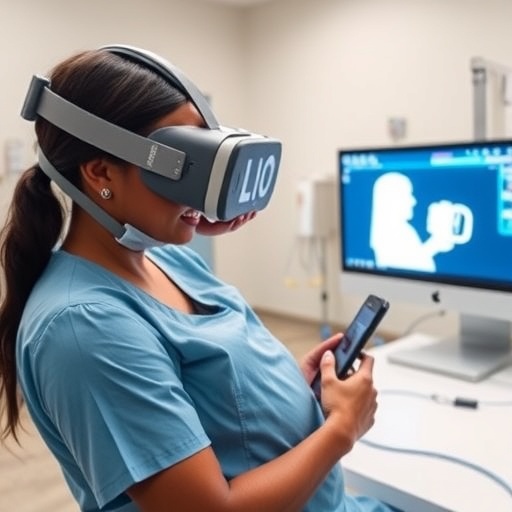PHILADELPHIA — Social media often features celebrities drinking cocktails, boozy how-to posts, and party pictures. This is the environment American teens are immersed in every day, with 71 percent of teens using more than one social media site, spending an average of nine hours a day using media. Despite the popularity of social media and alcohol-filled posts, little is known about the influence social media activity can have on teen and young adult and drinking behaviors.
Penn Medicine researchers, led by Brenda Curtis, PhD, an assistant professor of Psychology in Psychiatry in the Perelman School of Medicine at the University of Pennsylvania, reviewed data on these topics and found a statistically significant relationship and moderate effect sizes between alcohol related social media engagement and both alcohol consumption and alcohol-related problems. The meta-analysis findings were published in Alcoholism: Clinical and Experimental Research this week.
Curtis and colleagues identified 19 articles for the meta-analysis, representing data from more than 9,000 social media users across Facebook, Twitter, Instagram, and Snapchat. The analysis examined associations between young adults' alcohol-related social-media activity–defined as posting, liking, commenting on, and viewing of alcohol-related content on social media–and their reported drinking behaviors and problems. The drinking measures evaluated included alcohol consumption and problems such as regret after drinking, blacking out, and sustaining injuries while drinking.
About 57 percent of young adults and 9.2 percent of adolescents consumed alcohol in the past month. Despite the pervasive use of social media and alcohol consumption by young adults, little is known about the potential influence engagement with social media can have on this group's drinking patterns and risk of alcohol-related problems.
"Substance use, particularly alcohol, is frequently displayed on social media sites–this normalizes drinking for teens and young adults," Curtis said. "To date, reviews have considered drinking behavior in relation to risky behavior, such as binge drinking, or advertising content, rather than focusing on alcohol-related social media engagement. This meta-analysis allowed us to examine the relationship between alcohol-themed social media activity and alcohol consumption or alcohol-related problems in young adults."
Through evaluating the selected data, Curtis and team uncovered a moderate strength of relationship across all 19 studies. The analysis showed a correlation between alcohol-related social media engagement and alcohol consumption. Additionally, the research showed a statistically significant relationship between social media engagement and alcohol-related problems. However, the direction of these associations remains unknown.
"Further research to necessary so we can better understand the cause and relationship between social media and alcohol consumption," Curtis said. "This is especially important given that social-media sites can expose adolescents and young adults to alcohol content and marketing. This exposure may increase the likelihood of their drinking. Additional research can help determine the causal direction of these associations, which could provide opportunities for social-media-based interventions with young drinkers that incorporate machine learning, aimed at reducing alcohol consumption and alcohol-related issues."
###
Others involved in the research include Samantha Lookatch at Penn, Danielle Ramo at University of California-San Francisco School of Medicine, James McKay at Penn, Richard Feinn at Quinnipiac University, and Henry Kranzler at Penn. The research was supported in part by National Institute on Drug Abuse (R01DA039457) and the Veterans Integrated Service Network 4, Mental Illness Research, Education and Clinical Center, Crescenz VA Medical Center in Philadelphia.
Penn Medicine is one of the world's leading academic medical centers, dedicated to the related missions of medical education, biomedical research, and excellence in patient care. Penn Medicine consists of the Raymond and Ruth Perelman School of Medicine at the University of Pennsylvania (founded in 1765 as the nation's first medical school) and the University of Pennsylvania Health System, which together form a $7.8 billion enterprise.
The Perelman School of Medicine has been ranked among the top medical schools in the United States for more than 20 years, according to U.S. News & World Report's survey of research-oriented medical schools. The School is consistently among the nation's top recipients of funding from the National Institutes of Health, with $405 million awarded in the 2017 fiscal year.
The University of Pennsylvania Health System's patient care facilities include: The Hospital of the University of Pennsylvania and Penn Presbyterian Medical Center — which are recognized as one of the nation's top "Honor Roll" hospitals by U.S. News & World Report — Chester County Hospital; Lancaster General Health; Penn Medicine Princeton Health; Penn Wissahickon Hospice; and Pennsylvania Hospital – the nation's first hospital, founded in 1751. Additional affiliated inpatient care facilities and services throughout the Philadelphia region include Good Shepherd Penn Partners, a partnership between Good Shepherd Rehabilitation Network and Penn Medicine, and Princeton House Behavioral Health, a leading provider of highly skilled and compassionate behavioral healthcare.
Penn Medicine is committed to improving lives and health through a variety of community-based programs and activities. In fiscal year 2017, Penn Medicine provided $500 million to benefit our community.
Media Contact
Hannah Messinger
[email protected]
215-349-5653
@PennMedNews
http://www.uphs.upenn.edu/news/
http://dx.doi.org/10.1111/acer.13642




